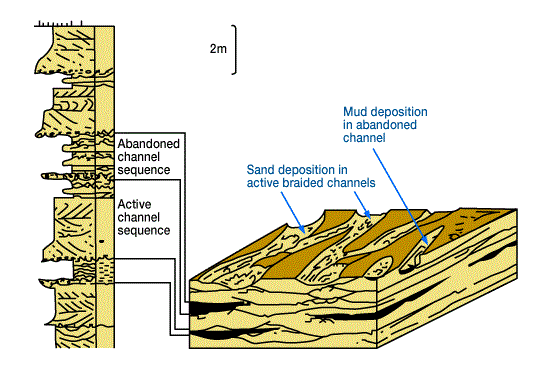Paleontology
As with alluvial fan lithologies, braided stream deposits are often colored red, orange, or yellowish by varying amounts of ferric iron. A second similarity is their general hostility to plant and animal life. Sudden flooding, which inundates and changes the specific configuration of channels and bars, prevents most colonization and also flushes out what organic remains may have settled on the immediate alluvial plain. Furthermore, groundwater percolating through buried sands is oxidizing and acidic, and might be expected to destroy or disfigure much original paleontologic evidence. Some burrowing or rootlet horizons may be preserved in shale layers, but on the whole, these sands are commonly barren and difficult to date.
Geometry
The geometry of braided stream deposits is usually sheet-like and can be extensive where numerous rivers were active or if tectonic tilting of the regional depositional surface caused the original river to migrate laterally. Margins may be irregular due to regional stratigraphic changes such as pinch out. This type of deposit will often be long and rather narrow, however. As shown by deposits at Prudhoe Bay and in the Sirte basin of northern Libya, total thickness can vary from hundreds to thousands of feet. Sandstone-conglomerate sequences enclose thin, discontinuous, relatively rare shale lenses.(Figure 1, Surface features and facies model of a braided channel system.

Sedimentation takes place almost entirely within the shifting complex of channels with some small silt deposition in abandoned channels. No flood plain exists; migration of the channel complex, due to tectonic tilting, for example, leads to the creation of extensive sand bodies.)
 Petro Shine The Place for Oil and Gas Professionals.
Petro Shine The Place for Oil and Gas Professionals.



